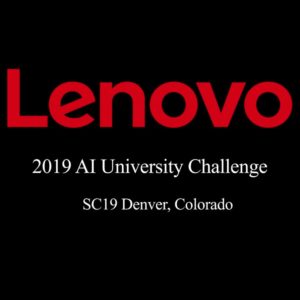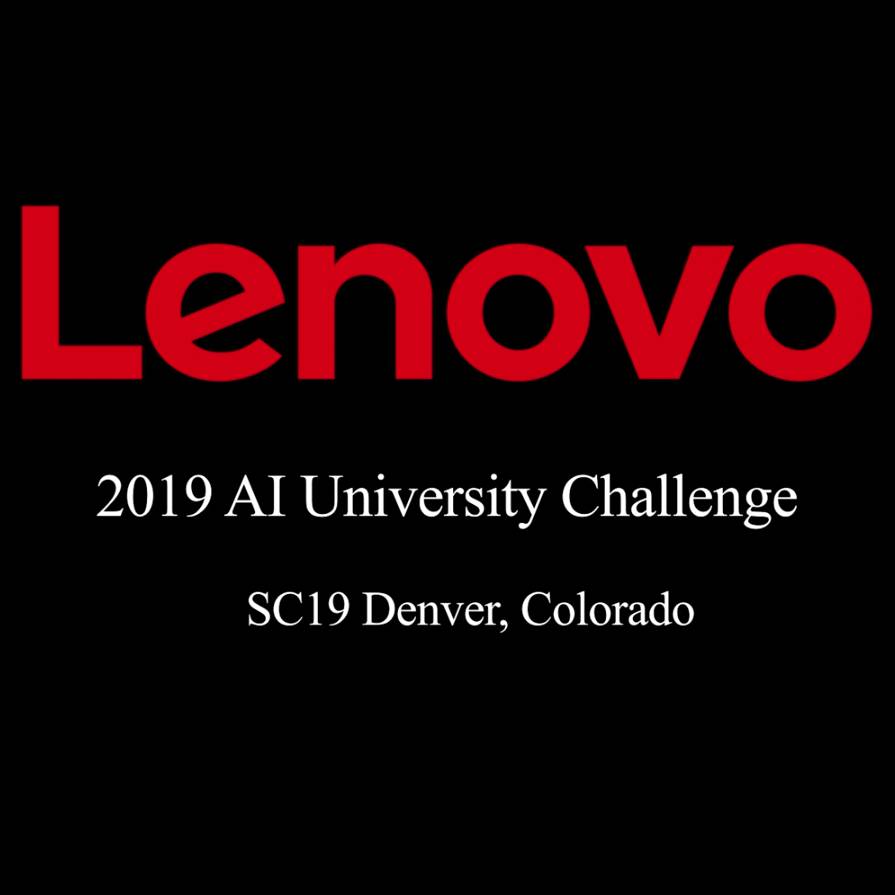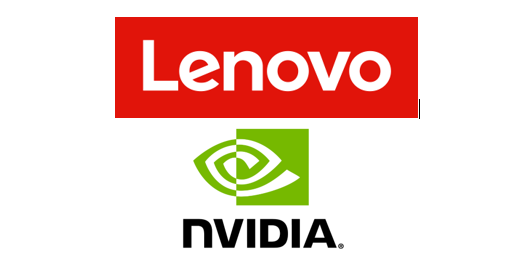In this special guest feature, Dan Olds from OrionX.net writes that university researchers had an opportunity to showcase their work at the third annual University AI Challenge at SC19.
 Lenovo and Intel sponsored the third annual AI University Challenge at SC19 in Denver, Colorado. The goal of the competition is to recognize outstanding university-based AI researchers for their achievements in the field. The companies sponsor the annual competition to foster AI research in universities world-wide.
Lenovo and Intel sponsored the third annual AI University Challenge at SC19 in Denver, Colorado. The goal of the competition is to recognize outstanding university-based AI researchers for their achievements in the field. The companies sponsor the annual competition to foster AI research in universities world-wide.
Winning researchers were rewarded with an all-expense paid trip to SC19 in Denver, along with the opportunity to present their research and findings at the Lenovo show floor theater. Eight researchers from universities in Europe, Asia, and North America were selected to win this award and all presented their research in the Lenovo theater during the exhibition.
The presenters gave audiences a glimpse of research that varied from how AI can combat prostate cancer to how it can fuel innovations in agriculture to how it is used to discover gravitational lenses. These were eye-opening presentations from the cutting edge of AI research today. The universities, presenters, and topics included:
University of Washington, US, Andrew Wildman, presenting a picture of how student-funded and managed compute resources have given University of Washington the ability to pursue their own projects and research. Andrew discussed a paper, “Fantastic Liquids and Where to Find Them”, that was the product of AI and Machine Learning computation that took place on the equipment owned by the university Research Computing Club. The point of his presentation was to show that if you allow students to run with their own ideas in a low risk environment, great things can happen. We certainly agree with that wholeheartedly.
Skolkovo Institute of Science & Technology, Maxim Federov, the director of the Center for Computational & Data-Intensive Science & Engineering for Skoltech discussed how the institute is approaching the challenge of AI as it relates to chemicals and pharma-tech. The potential number of compounds that can be synthesized is 10 to the 60th power (that’s a ten, followed by 60 zeroes!) – in other words, way too many to synthesize by hand. Skoltech is utilizing AI to discover promising new compounds at a much faster rate and at much lower costs. It’s a fascinating topic.
Inter-University Centre for Astronomy & Astrophysics, Dr. Anupretta More, discussed how she is using AI to discover gravitational lenses. Only 5% of the universe is composed of visible matter, Dark Matter composes another 25% and Dark Energy represents 70% of the total. The problem is that we know very little about Dark Matter and Dark Energy. Both of these components directly and strongly influence the universe. Einstein theorized that the gravity of massive objects will deflect the light waves in their vicinity. We see this proven out in gravitational lenses, which are caused when light bends around a massive object. These are very rare phenomena creating a needle-in-a-haystack problem: Thousands of scans of galaxies are needed to find the alignment of objects that result in a gravitational lens. Dr. More is using AI and supervised learning, along with shared volunteered processing to sift through millions and millions of images to find lenses and research dark matter and energy. Their record is a million classifications an hour!
Technical University of Denmark, Mia Siemon, presented her work titled “Semantic Image Segmentation for Dietary Assessment Using Deep Learning.” While that’s a complicated title, Mia’s work involves studying images of food in order to discover it’s caloric, fat and other dietary value without testing it physically. Is this even possible? Yes, as it turns out. The university’s ongoing project is to discover ways to understand the dietary values of food from a single image of a meal. In the video, Mia, discusses her project on semantic image segmentation, how she approached the challenge, and her results.
North Carolina State University, Dr. Ranga Vatsavai, discussed his research into how real-time AI can be used to fuel innovations in agriculture. As he pointed out in his presentation, 70% of our fresh water and 30% of our energy is consumed by our agricultural and food sectors. As much as 30% of the resulting food is wasted either through disease or improper cultivation or handling. With Earth’s population increasing rapidly, how can we scale up agriculture to feed everyone? Dr. Raju believes that AI and HPC can be harnessed to radically increase crop productivity. He shows how we can do this in the video below.
University of Chicago, Ping-Chang Lin, presents his research into how to automate prostate cancer detection using AI and Multi-Parametric MRI scans. Prostate cancer accounts for 20% of all new cancer cases for US men, thus it’s a big problem. However, the 5-year survival rate from prostate cancer is the highest among all types of diagnosed cancers – provided it is caught early enough. While MRI scans are increasingly used to detect prostate cancer, they can still miss up to 30% of the actual cases. Ping-Chang Lin presents how using deep learning and AI to classify MRI images can radically improve detection and thus increase lifespans.
Indian Institute of Technology, Sandip Sawarkar, presented his findings on how to understand atomic scale processes in materials using machine learning. He discussed how every material undergoes changes at the structural level, which can lead to problems with devices or complete failures. The atomic structure plays a key role in determining how a material will react to different situations. We’re constantly looking for new materials to fulfill a dizzying number of requirements for new products. –Modeling how a material will react is very expensive computationally. Is there a better way? Yes, according to Sandip, we can replace computationally expensive simulations with an Artificial Neural Network to simulate how materials will change under different conditions.
Harvard University, Raminder Singh, discussed how Harvard is embracing AI/ML/DO with edge computing. He works for the research lab at Harvard and revealed that his university is now driving a new 2 petaflop system recently delivered by Lenovo, which puts them on the Top500 list of the biggest supercomputers in the world. He presented two different use cases for edge computing and deep learning for brain research. The lab is collecting hundreds of video hours per day from rat cages and analyzing it with TensorFlow to see if the rats are developing motor skills. With more than ten researchers, all running their own research on the video becomes quite the data management problem. This problem has been solved by having a Raspberry Pi (a very small Arm-based computer) devoted to each cage, which controls the experiment and the video collection. The video data is reduced at the cage level and then transferred to the backend servers. The lab is also using AI and machine learning to predict activities ranging from sales renewals to the probability of attacks on ISP networks.
The Lenovo AI Challenge has once again recognized AI researchers who are pushing the boundaries of human knowledge in widely varied ways. The audiences enthusiastically viewed the presentations and had many questions afterwards, great job to Lenovo for organizing this event and making it possible.
Dan Olds is an Industry Analyst at OrionX.net. An authority on technology trends and customer sentiment, Dan Olds is a frequently quoted expert in industry and business publications such as The Wall Street Journal, Bloomberg News, Computerworld, eWeek, CIO, and PCWorld. In addition to server, storage, and network technologies, Dan closely follows the Big Data, Cloud, and HPC markets. He writes the HPC Blog on The Register, co-hosts the popular Radio Free HPC podcast, and is the go-to person for the coverage and analysis of the supercomputing industry’s Student Cluster Challenge.
See our complete coverage of SC19
Sign up for our insideHPC Newsletter




